Language Awareness: English Grammar Variation for Saudi Learners (KSU)
VerifiedAdded on 2020/04/21
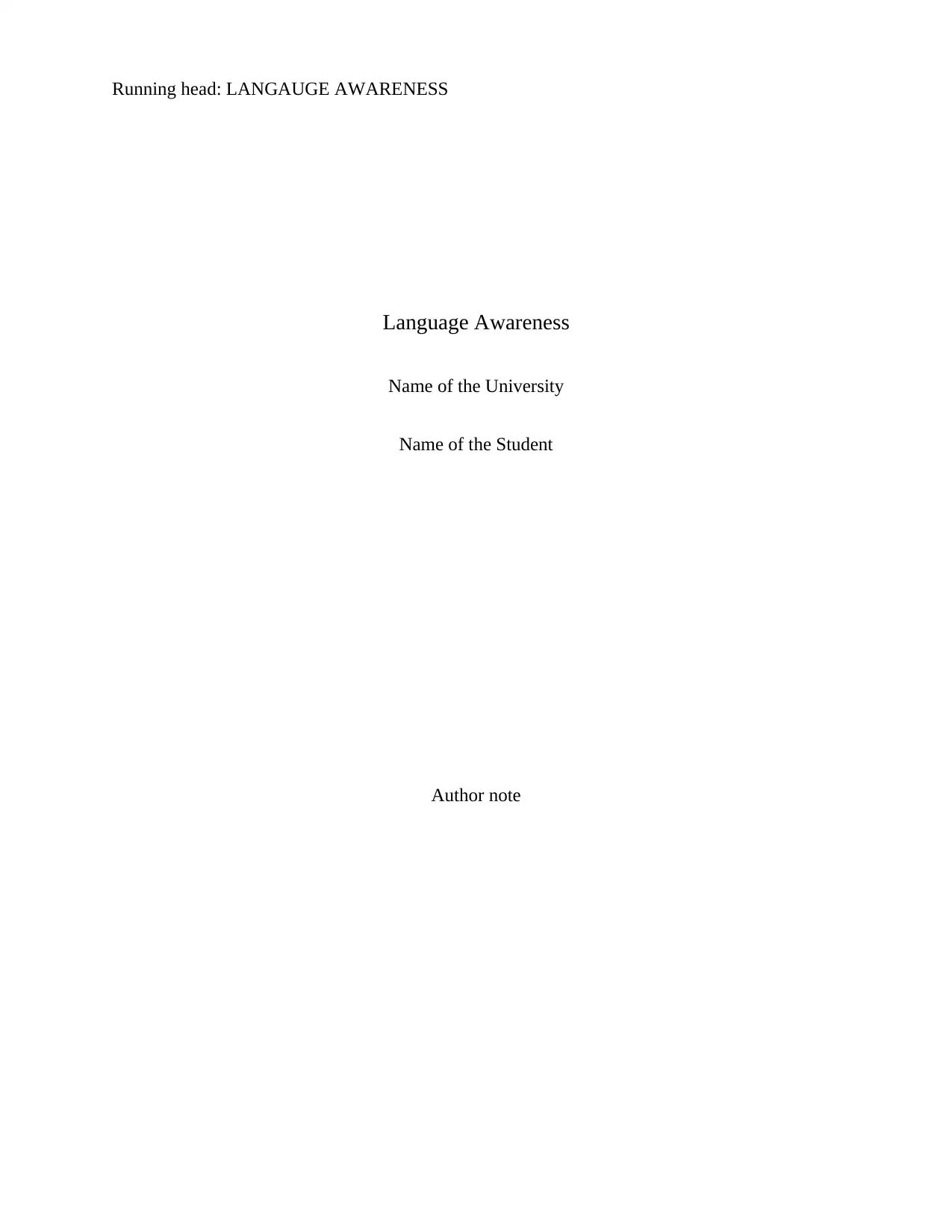
Language Awareness
Name of the University
Name of the Student
Author note
Paraphrase This Document
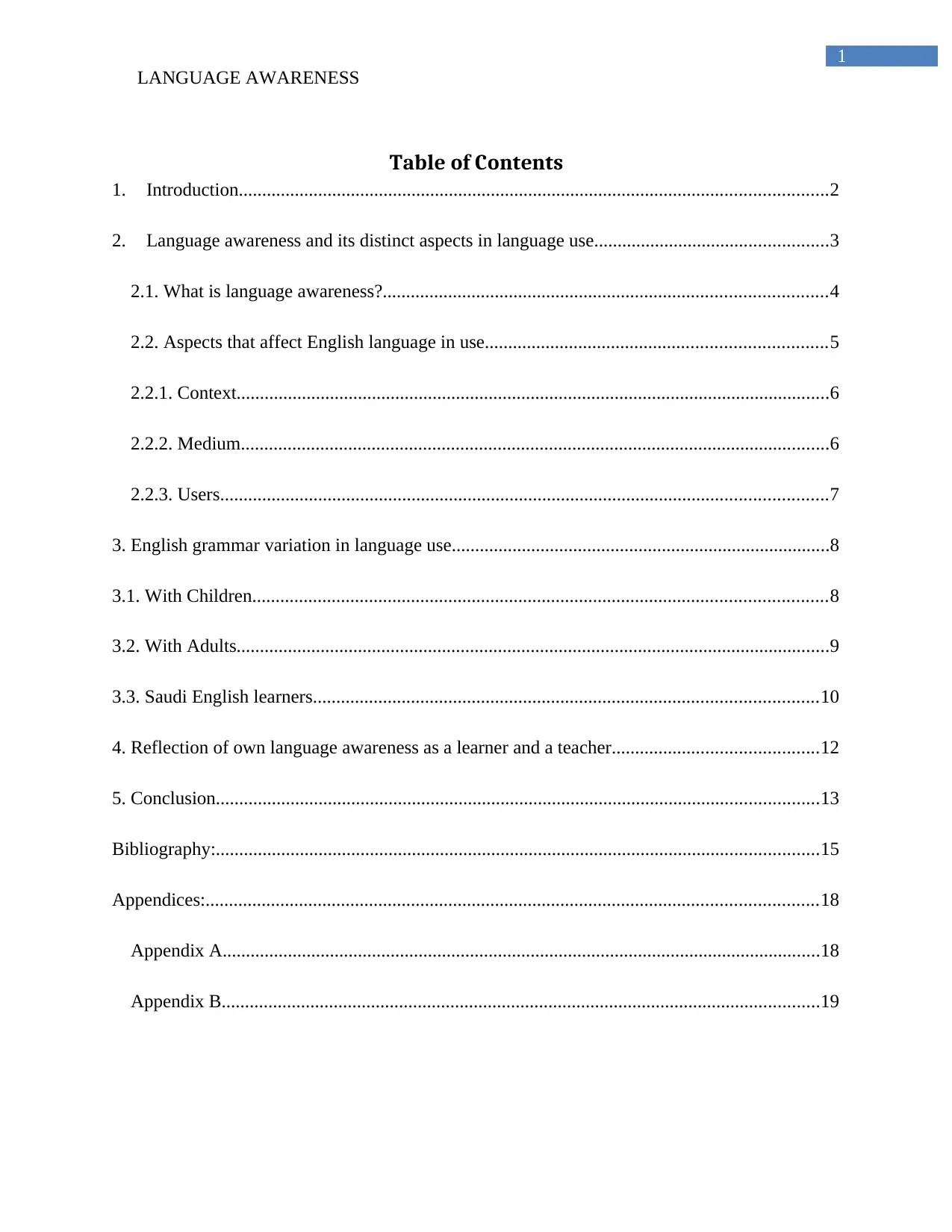
LANGUAGE AWARENESS
Table of Contents
1. Introduction..............................................................................................................................2
2. Language awareness and its distinct aspects in language use..................................................3
2.1. What is language awareness?...............................................................................................4
2.2. Aspects that affect English language in use.........................................................................5
2.2.1. Context...............................................................................................................................6
2.2.2. Medium..............................................................................................................................6
2.2.3. Users..................................................................................................................................7
3. English grammar variation in language use.................................................................................8
3.1. With Children...........................................................................................................................8
3.2. With Adults...............................................................................................................................9
3.3. Saudi English learners............................................................................................................10
4. Reflection of own language awareness as a learner and a teacher............................................12
5. Conclusion.................................................................................................................................13
Bibliography:.................................................................................................................................15
Appendices:...................................................................................................................................18
Appendix A................................................................................................................................18
Appendix B................................................................................................................................19

LANGUAGE AWARENESS
⊘ This is a preview!⊘
Do you want full access?
Subscribe today to unlock all pages.

Trusted by 1+ million students worldwide

LANGUAGE AWARENESS
1. Introduction
In teacher education concerning Teaching English to Speakers of Other Languages
(TESOL), Language awareness is a commonly used term that often refers to the skills to
teachers-in-training on LA mainly within the classroom (Ellis, 2012). Attaining awareness about
language requires teachers to first understand the very essence of language. Andrews (2006),
states, “language is patently important” to human beings. Without language, there can be no
scope for communication. A deep understanding of language comes from having awareness
about the language. Ronald (2003: 64) defines language awareness as “development in learners
of an enhanced consciousness of and sensitivity to the forms and functions of language”. The
‘forms and functions’ of language refer to the technicalities that are present in learning language.
The author further states that this approach of language awareness “has been developed in
contexts of both second and foreign language learning”. Language awareness combines content,
language skill, attitudinal education and meta-cognitive prospects enabling students to mirror the
process of language acquirement, learning and use. Classrooms centered on students and
assistance available to teachers in teaching English has been created in the modern day owing to
the focus on language awareness.
In this paper, I will explore the theoretical examination of LA and its significance in
developing teachers’ ability to teach the students of King Saud University (KSU), Saudi Arabia.
Further, I will present ideas about the influence of different features of language awareness on
the application of grammar. In addition, I will discuss the function of English in the teachers’
context. I will explain the manifestation of language awareness as both a learner and a teacher in
this paper. Ideas and concepts culminated from the evaluation would be presented as suggestions
and recommendations for teachers to pursue LA in order to achieve ELT competence.
Paraphrase This Document
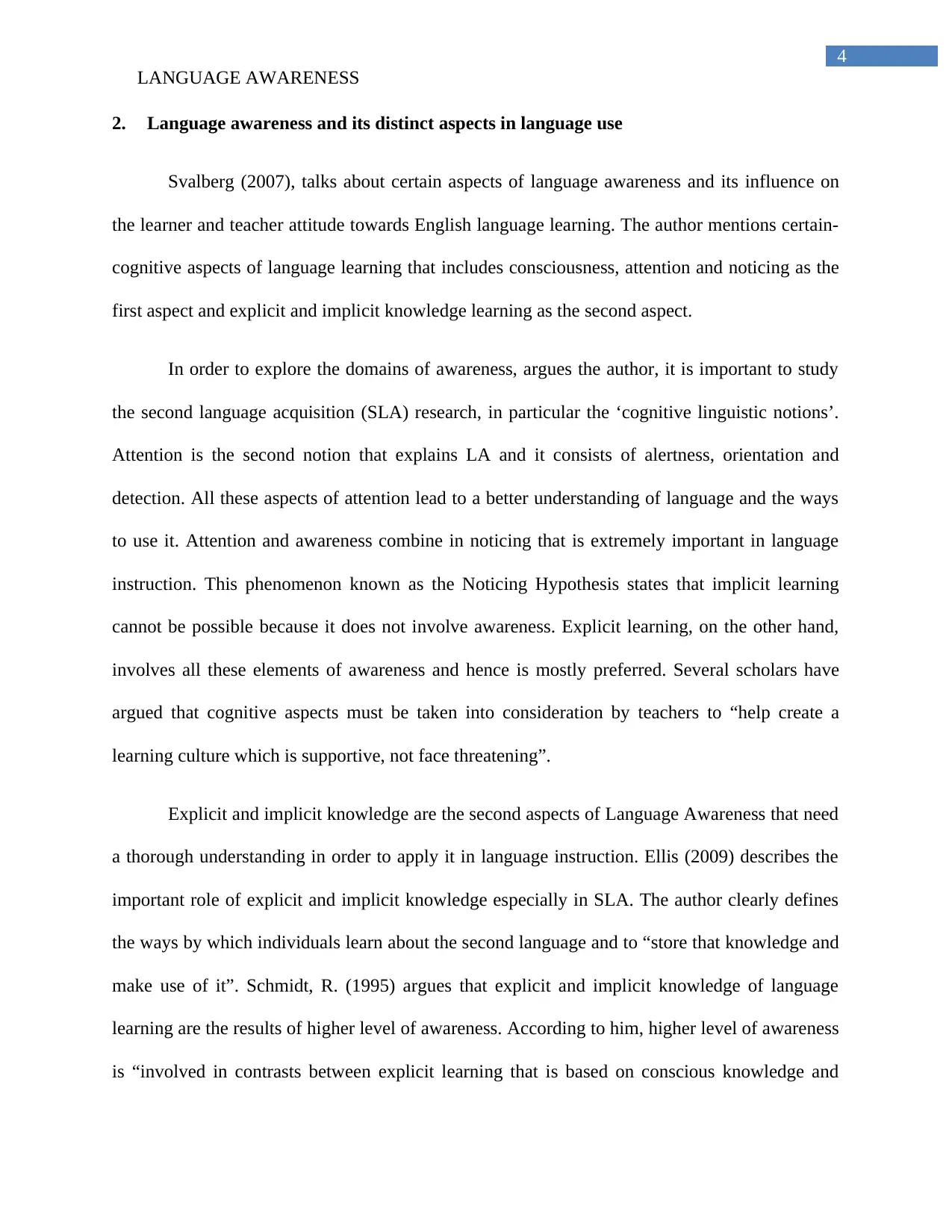
LANGUAGE AWARENESS
2. Language awareness and its distinct aspects in language use
Svalberg (2007), talks about certain aspects of language awareness and its influence on
the learner and teacher attitude towards English language learning. The author mentions certain-
cognitive aspects of language learning that includes consciousness, attention and noticing as the
first aspect and explicit and implicit knowledge learning as the second aspect.
In order to explore the domains of awareness, argues the author, it is important to study
the second language acquisition (SLA) research, in particular the ‘cognitive linguistic notions’.
Attention is the second notion that explains LA and it consists of alertness, orientation and
detection. All these aspects of attention lead to a better understanding of language and the ways
to use it. Attention and awareness combine in noticing that is extremely important in language
instruction. This phenomenon known as the Noticing Hypothesis states that implicit learning
cannot be possible because it does not involve awareness. Explicit learning, on the other hand,
involves all these elements of awareness and hence is mostly preferred. Several scholars have
argued that cognitive aspects must be taken into consideration by teachers to “help create a
learning culture which is supportive, not face threatening”.
Explicit and implicit knowledge are the second aspects of Language Awareness that need
a thorough understanding in order to apply it in language instruction. Ellis (2009) describes the
important role of explicit and implicit knowledge especially in SLA. The author clearly defines
the ways by which individuals learn about the second language and to “store that knowledge and
make use of it”. Schmidt, R. (1995) argues that explicit and implicit knowledge of language
learning are the results of higher level of awareness. According to him, higher level of awareness
is “involved in contrasts between explicit learning that is based on conscious knowledge and

LANGUAGE AWARENESS
insights and implicit learning, which bases itself on unconscious processes of generalization and
abstraction”. To break it in simple words, explicit learning requires calculated use of the
conscious mind to decipher the various meaning whereas implicit learning is processed naturally
through conversations with classmates and teachers.
Both the above-mentioned aspects of LA are inherent to the use of language while
providing instructions for SLA.
2.1. What is language awareness?
Tomlinson states that language awareness is a ‘mental attribute’ that enables learners to
‘gain insights into how languages work’. As per the definition of the Association for Language
Awareness (ALA), the term Language Awareness refers to the “explicit knowledge about
language, and conscious perception and sensitivity in language learning, language teaching and
language use”. To elaborate this definition further, language awareness encompasses overall
knowledge of language and involves minute observation and understanding of language learning,
teaching and use. Svalberg (2007) on the other hand, talks about the origin of the LA movement
during the 1990s and its transition to the present context of education. While putting for her
views, the author argues that language development in the 90s was limited to the efforts of the
teacher “to produce a literate workforce” and hence, no stress was laid on “developing a critical
understanding of the language”. In simple words, the early 20th century LA movement concerned
itself only with the production of a workforce that had enough literary skills. These skills were
however, restricted to technical areas only and lacked a holistic approach to language learning.
James, Garrett and Candlin (2014: 3), in their seminal work on LA, argued that theorists
and linguists have failed to provide a definitive explanation of the term. It thus led to debates and
⊘ This is a preview!⊘
Do you want full access?
Subscribe today to unlock all pages.

Trusted by 1+ million students worldwide
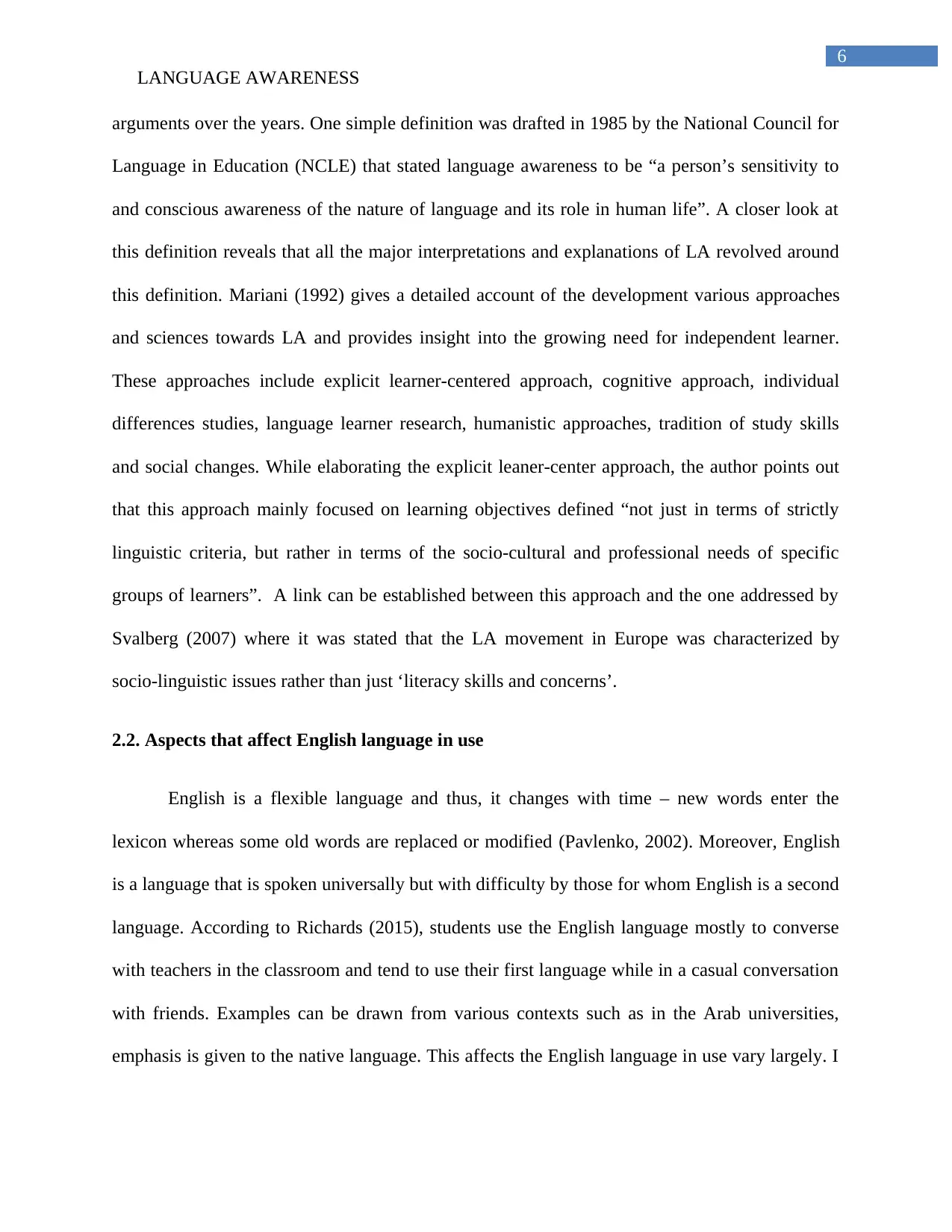
LANGUAGE AWARENESS
arguments over the years. One simple definition was drafted in 1985 by the National Council for
Language in Education (NCLE) that stated language awareness to be “a person’s sensitivity to
and conscious awareness of the nature of language and its role in human life”. A closer look at
this definition reveals that all the major interpretations and explanations of LA revolved around
this definition. Mariani (1992) gives a detailed account of the development various approaches
and sciences towards LA and provides insight into the growing need for independent learner.
These approaches include explicit learner-centered approach, cognitive approach, individual
differences studies, language learner research, humanistic approaches, tradition of study skills
and social changes. While elaborating the explicit leaner-center approach, the author points out
that this approach mainly focused on learning objectives defined “not just in terms of strictly
linguistic criteria, but rather in terms of the socio-cultural and professional needs of specific
groups of learners”. A link can be established between this approach and the one addressed by
Svalberg (2007) where it was stated that the LA movement in Europe was characterized by
socio-linguistic issues rather than just ‘literacy skills and concerns’.
2.2. Aspects that affect English language in use
English is a flexible language and thus, it changes with time – new words enter the
lexicon whereas some old words are replaced or modified (Pavlenko, 2002). Moreover, English
is a language that is spoken universally but with difficulty by those for whom English is a second
language. According to Richards (2015), students use the English language mostly to converse
with teachers in the classroom and tend to use their first language while in a casual conversation
with friends. Examples can be drawn from various contexts such as in the Arab universities,
emphasis is given to the native language. This affects the English language in use vary largely. I
Paraphrase This Document
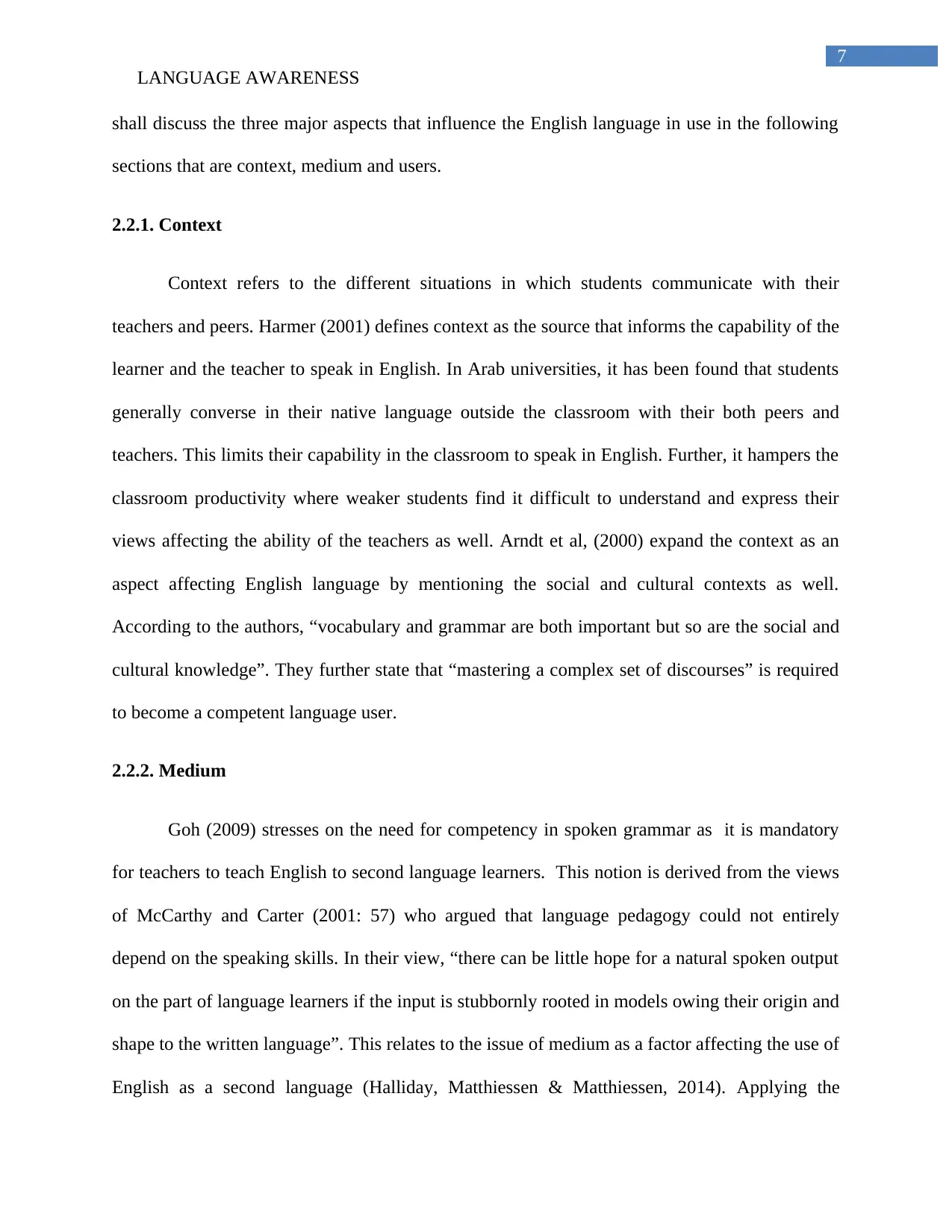
LANGUAGE AWARENESS
shall discuss the three major aspects that influence the English language in use in the following
sections that are context, medium and users.
2.2.1. Context
Context refers to the different situations in which students communicate with their
teachers and peers. Harmer (2001) defines context as the source that informs the capability of the
learner and the teacher to speak in English. In Arab universities, it has been found that students
generally converse in their native language outside the classroom with their both peers and
teachers. This limits their capability in the classroom to speak in English. Further, it hampers the
classroom productivity where weaker students find it difficult to understand and express their
views affecting the ability of the teachers as well. Arndt et al, (2000) expand the context as an
aspect affecting English language by mentioning the social and cultural contexts as well.
According to the authors, “vocabulary and grammar are both important but so are the social and
cultural knowledge”. They further state that “mastering a complex set of discourses” is required
to become a competent language user.
2.2.2. Medium
Goh (2009) stresses on the need for competency in spoken grammar as it is mandatory
for teachers to teach English to second language learners. This notion is derived from the views
of McCarthy and Carter (2001: 57) who argued that language pedagogy could not entirely
depend on the speaking skills. In their view, “there can be little hope for a natural spoken output
on the part of language learners if the input is stubbornly rooted in models owing their origin and
shape to the written language”. This relates to the issue of medium as a factor affecting the use of
English as a second language (Halliday, Matthiessen & Matthiessen, 2014). Applying the

LANGUAGE AWARENESS
technicalities of the written medium into spoken language disrupts the flow of teaching. Arndt et
al, (2000: 110), comment that although grammar is systematic, it is unstable and flexible and the
use of grammar “varies widely, particularly in spoken English”. It is crucial to identify the
differences between spoken and written English to understand thoroughly the nuances of
grammar. These variations in both verbal and written medium further affect the English language
and its awareness amongst students particularly for Saudi students.
2.2.3. Users
Language use varies according to different users. By users, I am referring to people of
different age groups, societal and cultural groups (Quezada-Sarmiento et al., 2017). In my
observation, I have found that the present generation tends to use a much-contracted form of
English. The affect of users in the use of English language is mostly visible from the grammar
that is used. Coates (2015) in her seminal work on gender and language sheds light on the works
of early grammarians and linguists who blamed women for the change in grammar. Here, we see
that the affect of users on the English language, particularly on grammar has been visible from
the earliest days. Apart from gender, English language in use is also affected by age groups.
Teenagers, as seen from their activities in the social media tend to use a shortened form of the
English language unlike adults. Using ‘lol’ in place of ‘laugh out loud’, ‘asap’ for ‘as soon as
possible’ and ‘omg’ for oh my god’ are some of the examples that show the drastic change in
language use depending on the user (Huffaker & Calvert, 2005). Users belonging to different
social backgrounds also demonstrate change is the use of English. Saudi people, for example,
mostly tend to omit or wrongly use articles ‘a, an and the’ while speaking in English. Khan
(2011) presents several examples of Saudi learners committing mistake while using the English
⊘ This is a preview!⊘
Do you want full access?
Subscribe today to unlock all pages.

Trusted by 1+ million students worldwide
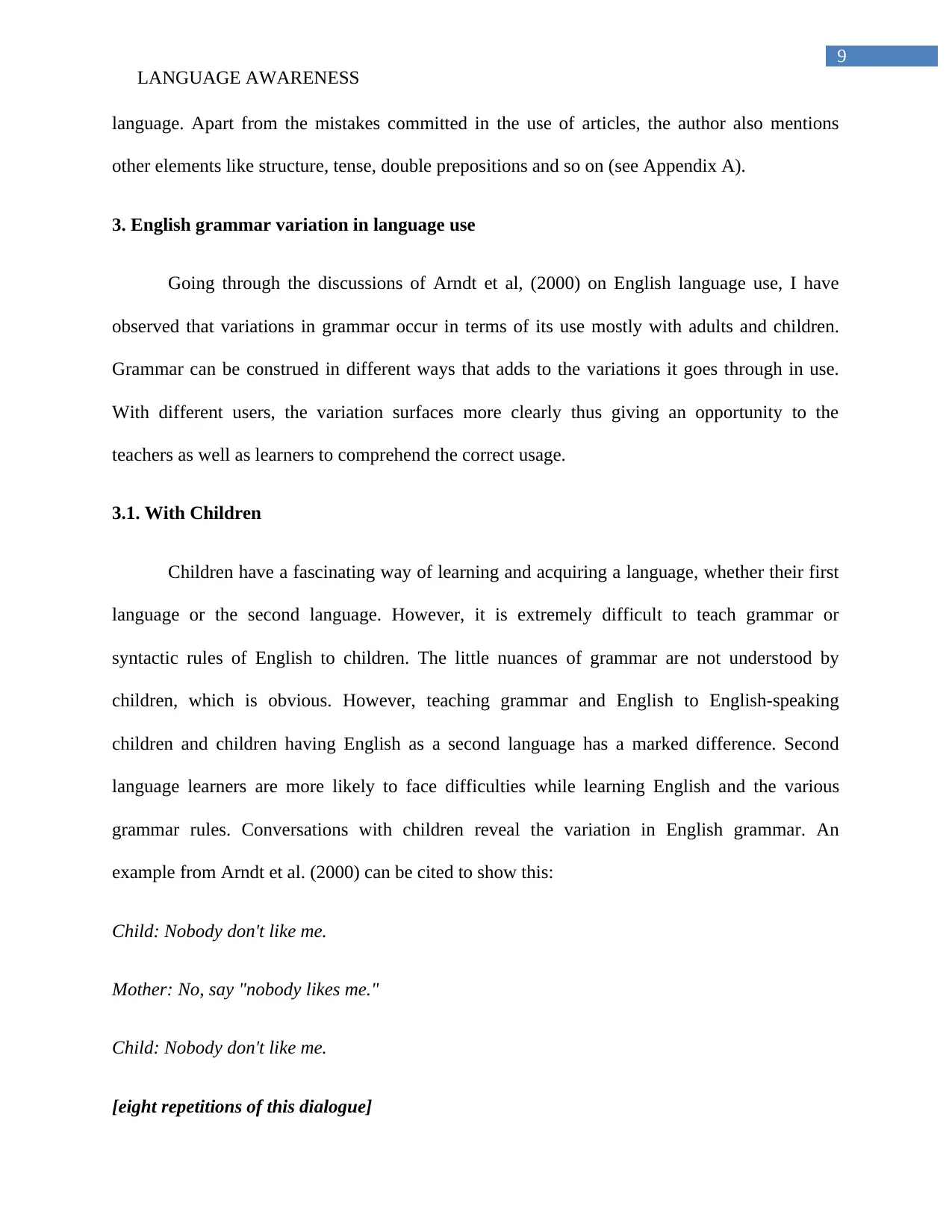
LANGUAGE AWARENESS
language. Apart from the mistakes committed in the use of articles, the author also mentions
other elements like structure, tense, double prepositions and so on (see Appendix A).
3. English grammar variation in language use
Going through the discussions of Arndt et al, (2000) on English language use, I have
observed that variations in grammar occur in terms of its use mostly with adults and children.
Grammar can be construed in different ways that adds to the variations it goes through in use.
With different users, the variation surfaces more clearly thus giving an opportunity to the
teachers as well as learners to comprehend the correct usage.
3.1. With Children
Children have a fascinating way of learning and acquiring a language, whether their first
language or the second language. However, it is extremely difficult to teach grammar or
syntactic rules of English to children. The little nuances of grammar are not understood by
children, which is obvious. However, teaching grammar and English to English-speaking
children and children having English as a second language has a marked difference. Second
language learners are more likely to face difficulties while learning English and the various
grammar rules. Conversations with children reveal the variation in English grammar. An
example from Arndt et al. (2000) can be cited to show this:
Child: Nobody don't like me.
Mother: No, say "nobody likes me."
Child: Nobody don't like me.
[eight repetitions of this dialogue]
Paraphrase This Document

LANGUAGE AWARENESS
Mother: No, now listen carefully: say "nobody likes me."
Child: Oh! Nobody don't LIKES me.
Here, from the above example, variation in grammar use can be clearly visible. The child
juxtaposes two negative words, as it does not have a developed idea about it. The child observes
and follows what he or she sees and listens. My own experience has helped me observe these
little variations in the English language while conversing with children and listening to them. I
have observed that he possesses no idea about grammar and tends to mix preposition and
conjunction. Instead of saying, “I saw a cat under the table”, my cousin says “I seen a cat in the
table”. Further, in place of using ‘and’, my cousin uses ‘or’ and sometimes even miss using
conjunctions. It is thus evident from the above examples and personal experiences that English
grammar varies with children beginning to learn the language and with first and second language
speakers as well. As stated by Hinkel (2018), grammar and its rules has its own variation that is
explored at deeper levels when it is used by children and instructors teaching English to children.
3.2. With Adults
Adults are more informed about the various rules and techniques of English grammar and
thus commit fewer mistakes than children while speaking and writing commit. However, marked
differences could be visible between L1 and L2 learners (Alrabai, 2014). While L1 learners have
a wider scope of learning English being equipped with wide range of grammatical structures, L2
learners do not have such a scope. This leads to variations in English grammar usage. A look at
the usage of written and spoken English by L1 learners presented in the work of Arndt et al.
(2000: 108,109) reveals this variation (see Appendix B).
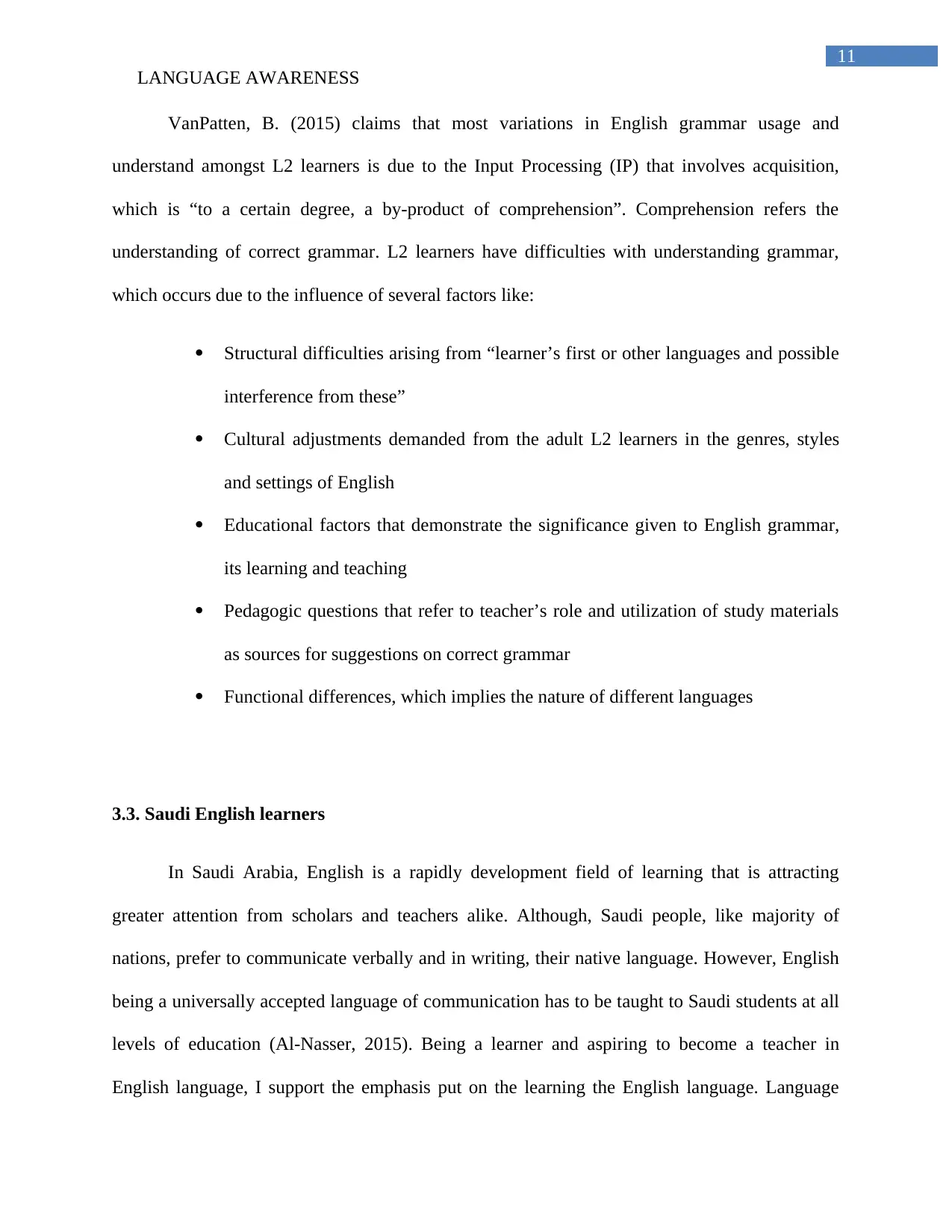
LANGUAGE AWARENESS
VanPatten, B. (2015) claims that most variations in English grammar usage and
understand amongst L2 learners is due to the Input Processing (IP) that involves acquisition,
which is “to a certain degree, a by-product of comprehension”. Comprehension refers the
understanding of correct grammar. L2 learners have difficulties with understanding grammar,
which occurs due to the influence of several factors like:
Structural difficulties arising from “learner’s first or other languages and possible
interference from these”
Cultural adjustments demanded from the adult L2 learners in the genres, styles
and settings of English
Educational factors that demonstrate the significance given to English grammar,
its learning and teaching
Pedagogic questions that refer to teacher’s role and utilization of study materials
as sources for suggestions on correct grammar
Functional differences, which implies the nature of different languages
3.3. Saudi English learners
In Saudi Arabia, English is a rapidly development field of learning that is attracting
greater attention from scholars and teachers alike. Although, Saudi people, like majority of
nations, prefer to communicate verbally and in writing, their native language. However, English
being a universally accepted language of communication has to be taught to Saudi students at all
levels of education (Al-Nasser, 2015). Being a learner and aspiring to become a teacher in
English language, I support the emphasis put on the learning the English language. Language
⊘ This is a preview!⊘
Do you want full access?
Subscribe today to unlock all pages.

Trusted by 1+ million students worldwide
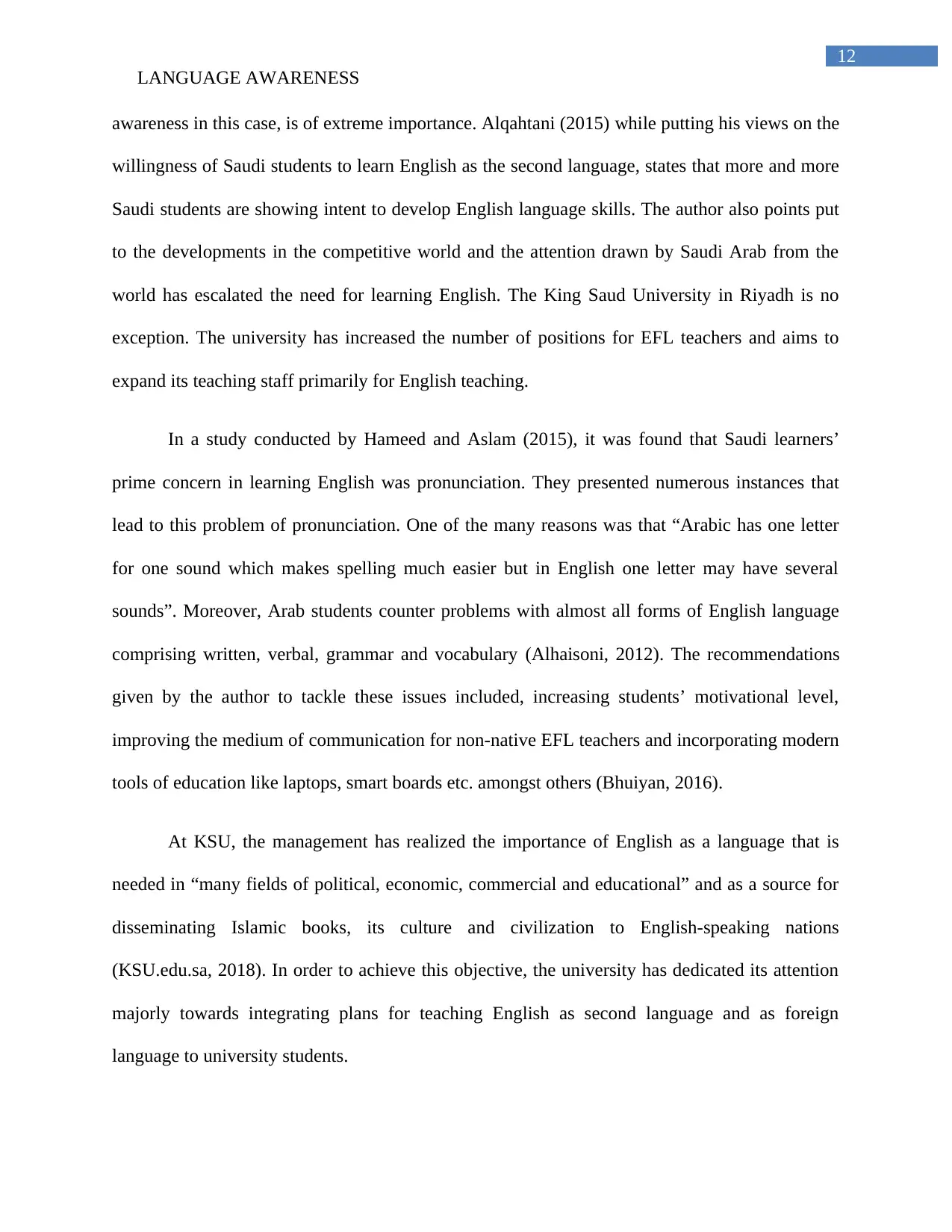
LANGUAGE AWARENESS
awareness in this case, is of extreme importance. Alqahtani (2015) while putting his views on the
willingness of Saudi students to learn English as the second language, states that more and more
Saudi students are showing intent to develop English language skills. The author also points put
to the developments in the competitive world and the attention drawn by Saudi Arab from the
world has escalated the need for learning English. The King Saud University in Riyadh is no
exception. The university has increased the number of positions for EFL teachers and aims to
expand its teaching staff primarily for English teaching.
In a study conducted by Hameed and Aslam (2015), it was found that Saudi learners’
prime concern in learning English was pronunciation. They presented numerous instances that
lead to this problem of pronunciation. One of the many reasons was that “Arabic has one letter
for one sound which makes spelling much easier but in English one letter may have several
sounds”. Moreover, Arab students counter problems with almost all forms of English language
comprising written, verbal, grammar and vocabulary (Alhaisoni, 2012). The recommendations
given by the author to tackle these issues included, increasing students’ motivational level,
improving the medium of communication for non-native EFL teachers and incorporating modern
tools of education like laptops, smart boards etc. amongst others (Bhuiyan, 2016).
At KSU, the management has realized the importance of English as a language that is
needed in “many fields of political, economic, commercial and educational” and as a source for
disseminating Islamic books, its culture and civilization to English-speaking nations
(KSU.edu.sa, 2018). In order to achieve this objective, the university has dedicated its attention
majorly towards integrating plans for teaching English as second language and as foreign
language to university students.
Paraphrase This Document
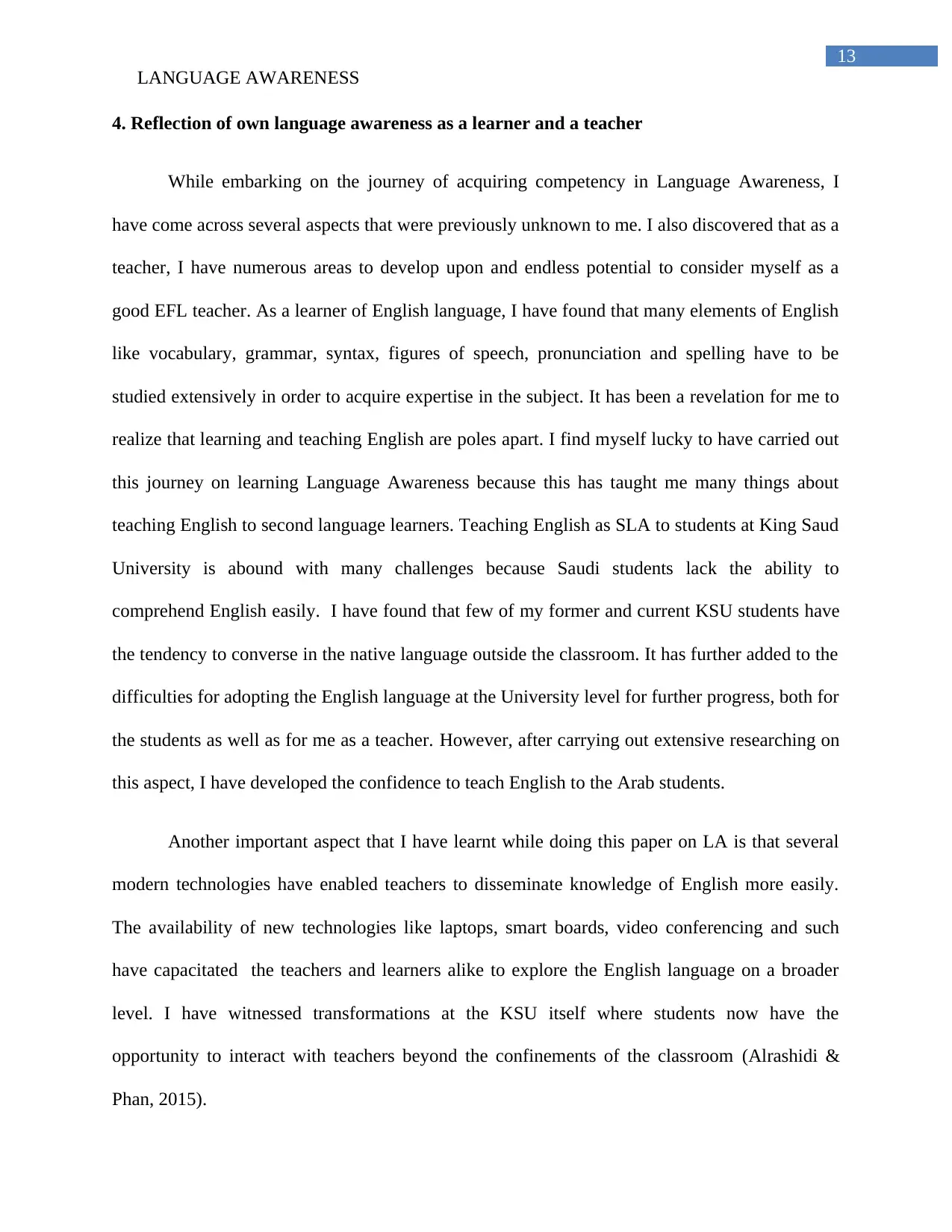
LANGUAGE AWARENESS
4. Reflection of own language awareness as a learner and a teacher
While embarking on the journey of acquiring competency in Language Awareness, I
have come across several aspects that were previously unknown to me. I also discovered that as a
teacher, I have numerous areas to develop upon and endless potential to consider myself as a
good EFL teacher. As a learner of English language, I have found that many elements of English
like vocabulary, grammar, syntax, figures of speech, pronunciation and spelling have to be
studied extensively in order to acquire expertise in the subject. It has been a revelation for me to
realize that learning and teaching English are poles apart. I find myself lucky to have carried out
this journey on learning Language Awareness because this has taught me many things about
teaching English to second language learners. Teaching English as SLA to students at King Saud
University is abound with many challenges because Saudi students lack the ability to
comprehend English easily. I have found that few of my former and current KSU students have
the tendency to converse in the native language outside the classroom. It has further added to the
difficulties for adopting the English language at the University level for further progress, both for
the students as well as for me as a teacher. However, after carrying out extensive researching on
this aspect, I have developed the confidence to teach English to the Arab students.
Another important aspect that I have learnt while doing this paper on LA is that several
modern technologies have enabled teachers to disseminate knowledge of English more easily.
The availability of new technologies like laptops, smart boards, video conferencing and such
have capacitated the teachers and learners alike to explore the English language on a broader
level. I have witnessed transformations at the KSU itself where students now have the
opportunity to interact with teachers beyond the confinements of the classroom (Alrashidi &
Phan, 2015).
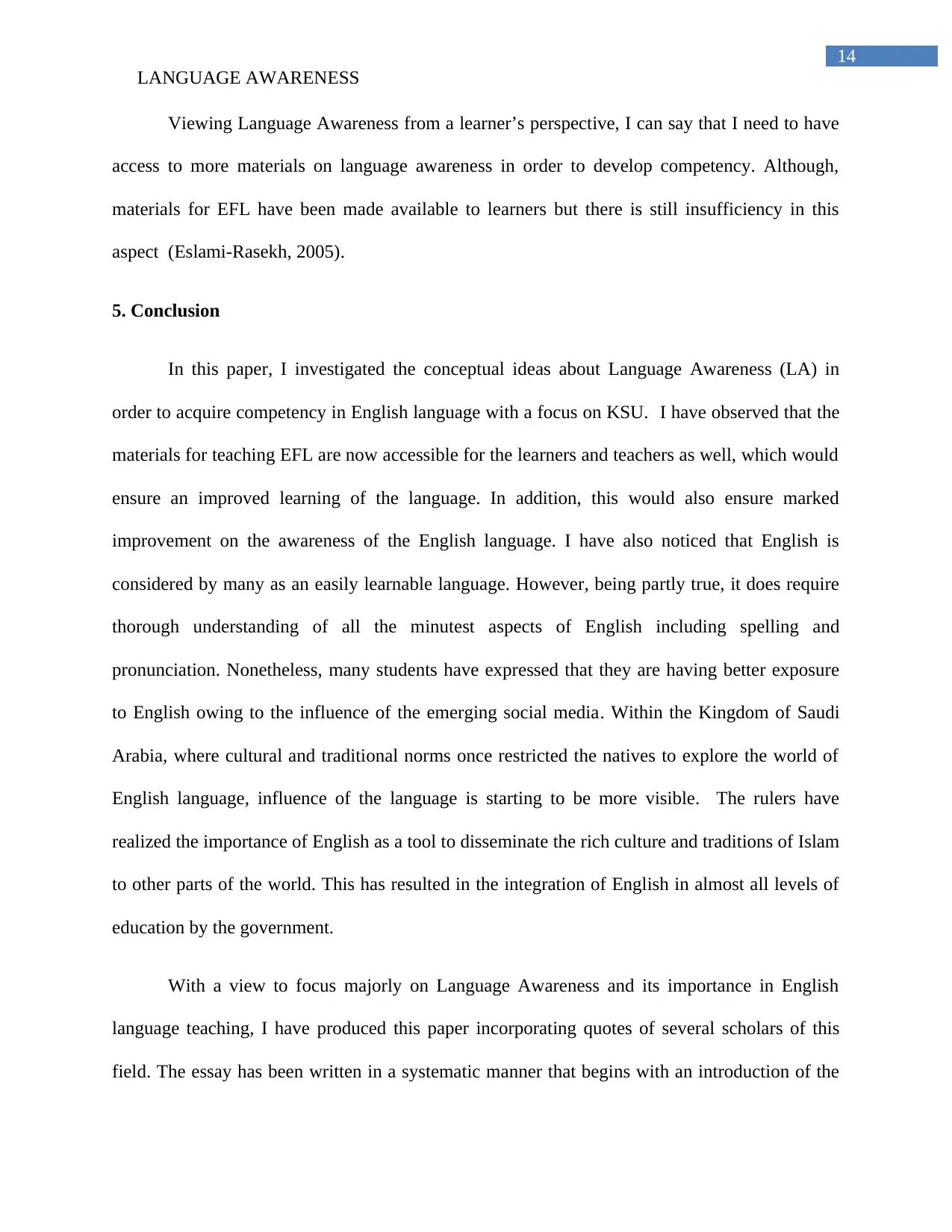
LANGUAGE AWARENESS
Viewing Language Awareness from a learner’s perspective, I can say that I need to have
access to more materials on language awareness in order to develop competency. Although,
materials for EFL have been made available to learners but there is still insufficiency in this
aspect (Eslami-Rasekh, 2005).
5. Conclusion
In this paper, I investigated the conceptual ideas about Language Awareness (LA) in
order to acquire competency in English language with a focus on KSU. I have observed that the
materials for teaching EFL are now accessible for the learners and teachers as well, which would
ensure an improved learning of the language. In addition, this would also ensure marked
improvement on the awareness of the English language. I have also noticed that English is
considered by many as an easily learnable language. However, being partly true, it does require
thorough understanding of all the minutest aspects of English including spelling and
pronunciation. Nonetheless, many students have expressed that they are having better exposure
to English owing to the influence of the emerging social media. Within the Kingdom of Saudi
Arabia, where cultural and traditional norms once restricted the natives to explore the world of
English language, influence of the language is starting to be more visible. The rulers have
realized the importance of English as a tool to disseminate the rich culture and traditions of Islam
to other parts of the world. This has resulted in the integration of English in almost all levels of
education by the government.
With a view to focus majorly on Language Awareness and its importance in English
language teaching, I have produced this paper incorporating quotes of several scholars of this
field. The essay has been written in a systematic manner that begins with an introduction of the
⊘ This is a preview!⊘
Do you want full access?
Subscribe today to unlock all pages.

Trusted by 1+ million students worldwide
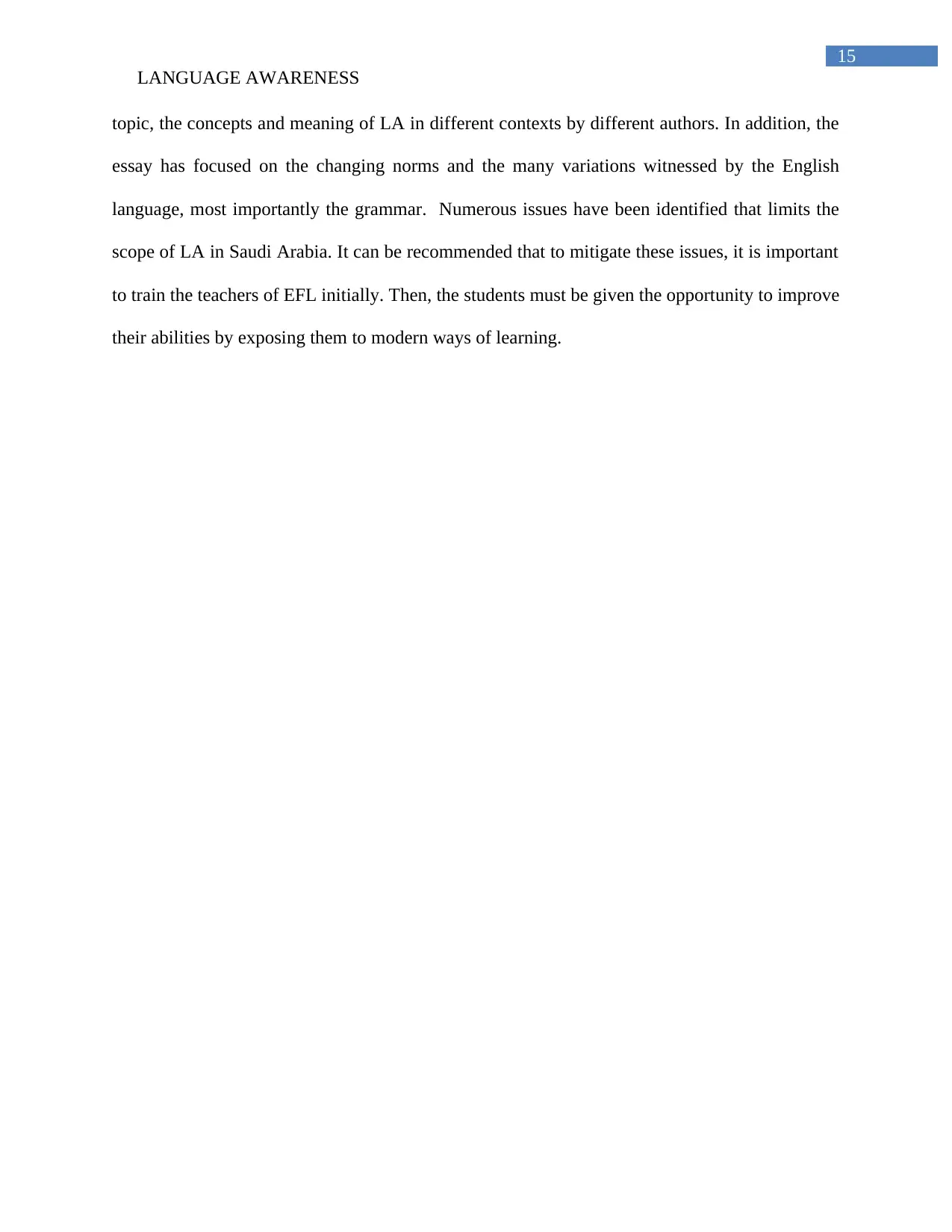
LANGUAGE AWARENESS
topic, the concepts and meaning of LA in different contexts by different authors. In addition, the
essay has focused on the changing norms and the many variations witnessed by the English
language, most importantly the grammar. Numerous issues have been identified that limits the
scope of LA in Saudi Arabia. It can be recommended that to mitigate these issues, it is important
to train the teachers of EFL initially. Then, the students must be given the opportunity to improve
their abilities by exposing them to modern ways of learning.
Paraphrase This Document
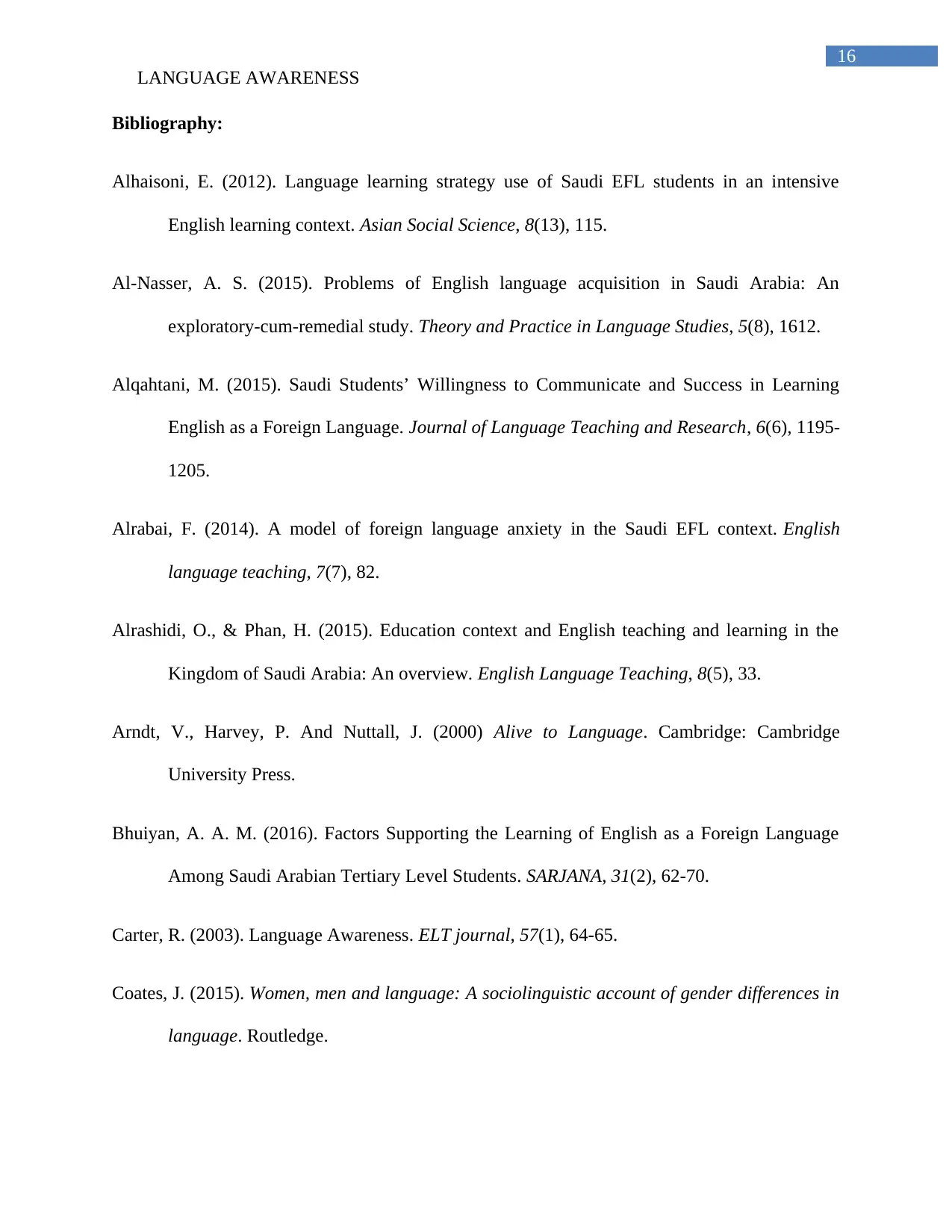
LANGUAGE AWARENESS
Bibliography:
Alhaisoni, E. (2012). Language learning strategy use of Saudi EFL students in an intensive
English learning context. Asian Social Science, 8(13), 115.
Al-Nasser, A. S. (2015). Problems of English language acquisition in Saudi Arabia: An
exploratory-cum-remedial study. Theory and Practice in Language Studies, 5(8), 1612.
Alqahtani, M. (2015). Saudi Students’ Willingness to Communicate and Success in Learning
English as a Foreign Language. Journal of Language Teaching and Research, 6(6), 1195-
1205.
Alrabai, F. (2014). A model of foreign language anxiety in the Saudi EFL context. English
language teaching, 7(7), 82.
Alrashidi, O., & Phan, H. (2015). Education context and English teaching and learning in the
Kingdom of Saudi Arabia: An overview. English Language Teaching, 8(5), 33.
Arndt, V., Harvey, P. And Nuttall, J. (2000) Alive to Language. Cambridge: Cambridge
University Press.
Bhuiyan, A. A. M. (2016). Factors Supporting the Learning of English as a Foreign Language
Among Saudi Arabian Tertiary Level Students. SARJANA, 31(2), 62-70.
Carter, R. (2003). Language Awareness. ELT journal, 57(1), 64-65.
Coates, J. (2015). Women, men and language: A sociolinguistic account of gender differences in
language. Routledge.
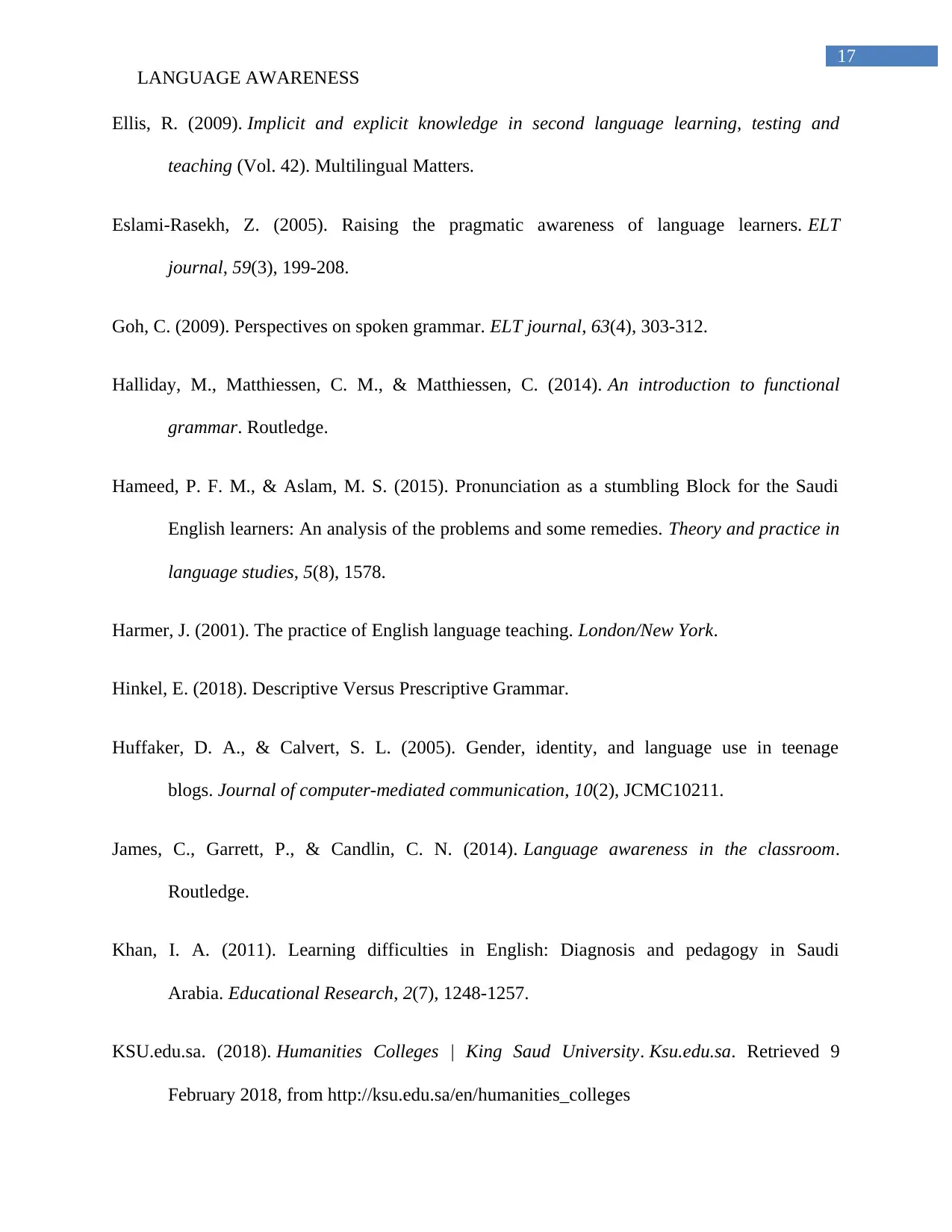
LANGUAGE AWARENESS
Ellis, R. (2009). Implicit and explicit knowledge in second language learning, testing and
teaching (Vol. 42). Multilingual Matters.
Eslami-Rasekh, Z. (2005). Raising the pragmatic awareness of language learners. ELT
journal, 59(3), 199-208.
Goh, C. (2009). Perspectives on spoken grammar. ELT journal, 63(4), 303-312.
Halliday, M., Matthiessen, C. M., & Matthiessen, C. (2014). An introduction to functional
grammar. Routledge.
Hameed, P. F. M., & Aslam, M. S. (2015). Pronunciation as a stumbling Block for the Saudi
English learners: An analysis of the problems and some remedies. Theory and practice in
language studies, 5(8), 1578.
Harmer, J. (2001). The practice of English language teaching. London/New York.
Hinkel, E. (2018). Descriptive Versus Prescriptive Grammar.
Huffaker, D. A., & Calvert, S. L. (2005). Gender, identity, and language use in teenage
blogs. Journal of computer-mediated communication, 10(2), JCMC10211.
James, C., Garrett, P., & Candlin, C. N. (2014). Language awareness in the classroom.
Routledge.
Khan, I. A. (2011). Learning difficulties in English: Diagnosis and pedagogy in Saudi
Arabia. Educational Research, 2(7), 1248-1257.
KSU.edu.sa. (2018). Humanities Colleges | King Saud University. Ksu.edu.sa. Retrieved 9
February 2018, from http://ksu.edu.sa/en/humanities_colleges
⊘ This is a preview!⊘
Do you want full access?
Subscribe today to unlock all pages.

Trusted by 1+ million students worldwide
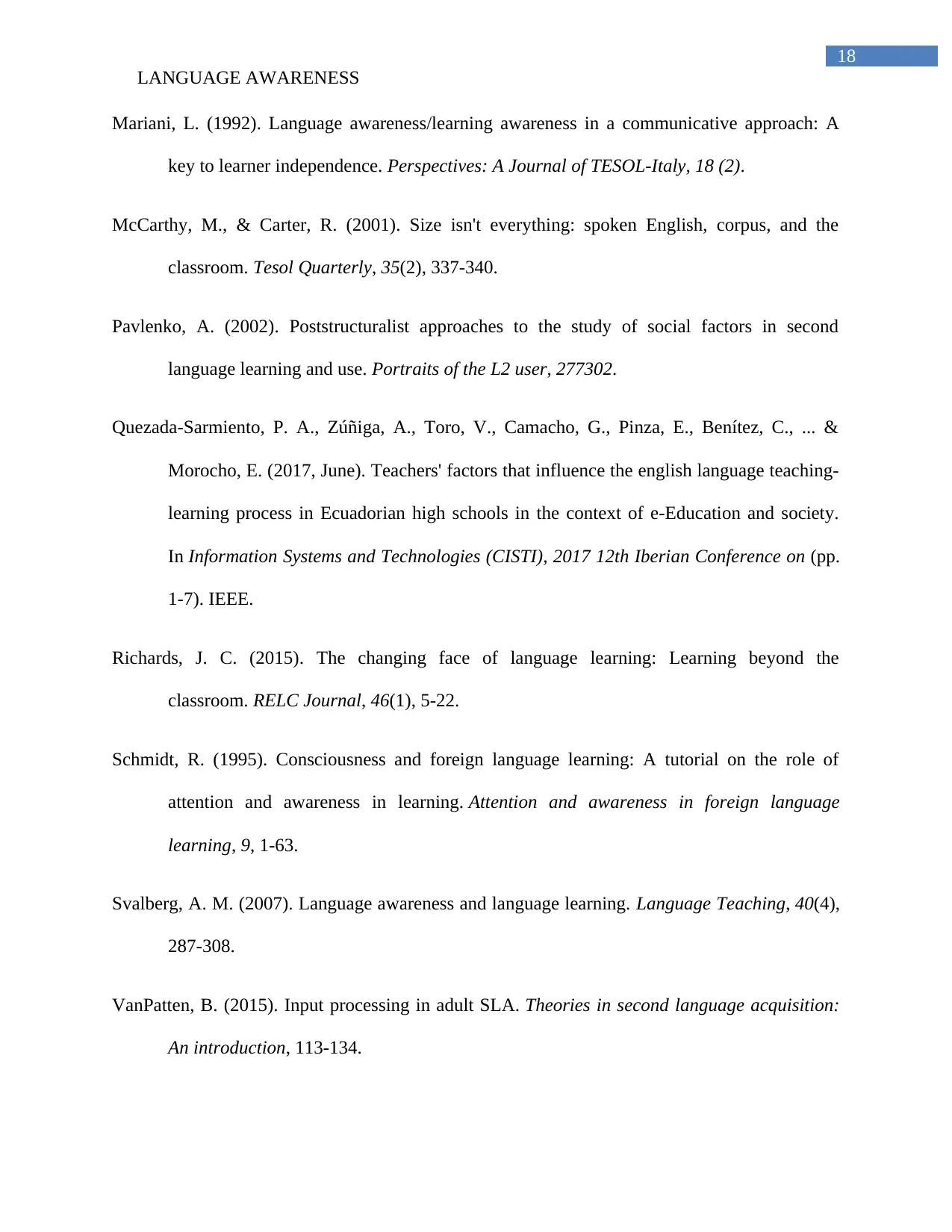
LANGUAGE AWARENESS
Mariani, L. (1992). Language awareness/learning awareness in a communicative approach: A
key to learner independence. Perspectives: A Journal of TESOL-Italy, 18 (2).
McCarthy, M., & Carter, R. (2001). Size isn't everything: spoken English, corpus, and the
classroom. Tesol Quarterly, 35(2), 337-340.
Pavlenko, A. (2002). Poststructuralist approaches to the study of social factors in second
language learning and use. Portraits of the L2 user, 277302.
Quezada-Sarmiento, P. A., Zúñiga, A., Toro, V., Camacho, G., Pinza, E., Benítez, C., ... &
Morocho, E. (2017, June). Teachers' factors that influence the english language teaching-
learning process in Ecuadorian high schools in the context of e-Education and society.
In Information Systems and Technologies (CISTI), 2017 12th Iberian Conference on (pp.
1-7). IEEE.
Richards, J. C. (2015). The changing face of language learning: Learning beyond the
classroom. RELC Journal, 46(1), 5-22.
Schmidt, R. (1995). Consciousness and foreign language learning: A tutorial on the role of
attention and awareness in learning. Attention and awareness in foreign language
learning, 9, 1-63.
Svalberg, A. M. (2007). Language awareness and language learning. Language Teaching, 40(4),
287-308.
VanPatten, B. (2015). Input processing in adult SLA. Theories in second language acquisition:
An introduction, 113-134.
Paraphrase This Document
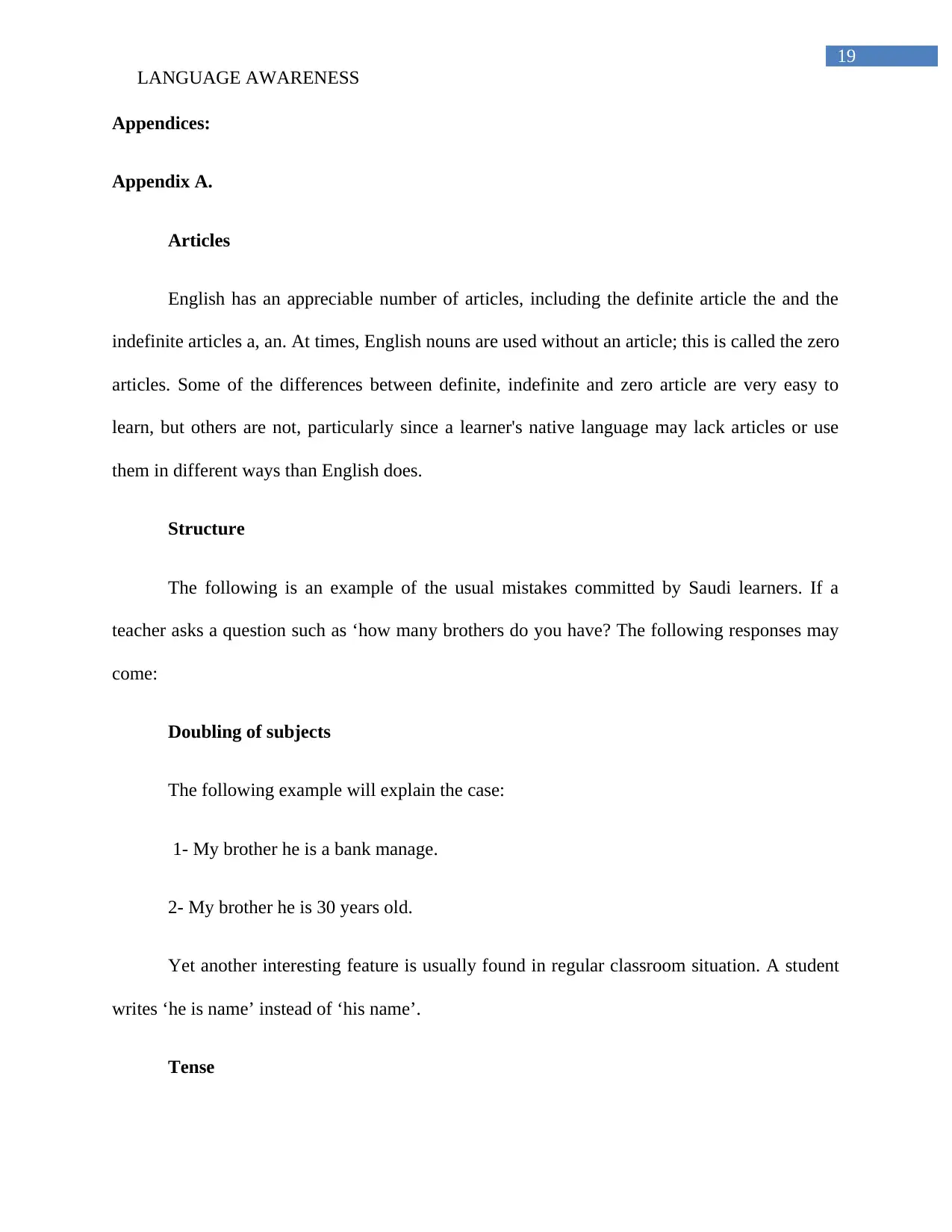
LANGUAGE AWARENESS
Appendices:
Appendix A.
Articles
English has an appreciable number of articles, including the definite article the and the
indefinite articles a, an. At times, English nouns are used without an article; this is called the zero
articles. Some of the differences between definite, indefinite and zero article are very easy to
learn, but others are not, particularly since a learner's native language may lack articles or use
them in different ways than English does.
Structure
The following is an example of the usual mistakes committed by Saudi learners. If a
teacher asks a question such as ‘how many brothers do you have? The following responses may
come:
Doubling of subjects
The following example will explain the case:
1- My brother he is a bank manage.
2- My brother he is 30 years old.
Yet another interesting feature is usually found in regular classroom situation. A student
writes ‘he is name’ instead of ‘his name’.
Tense
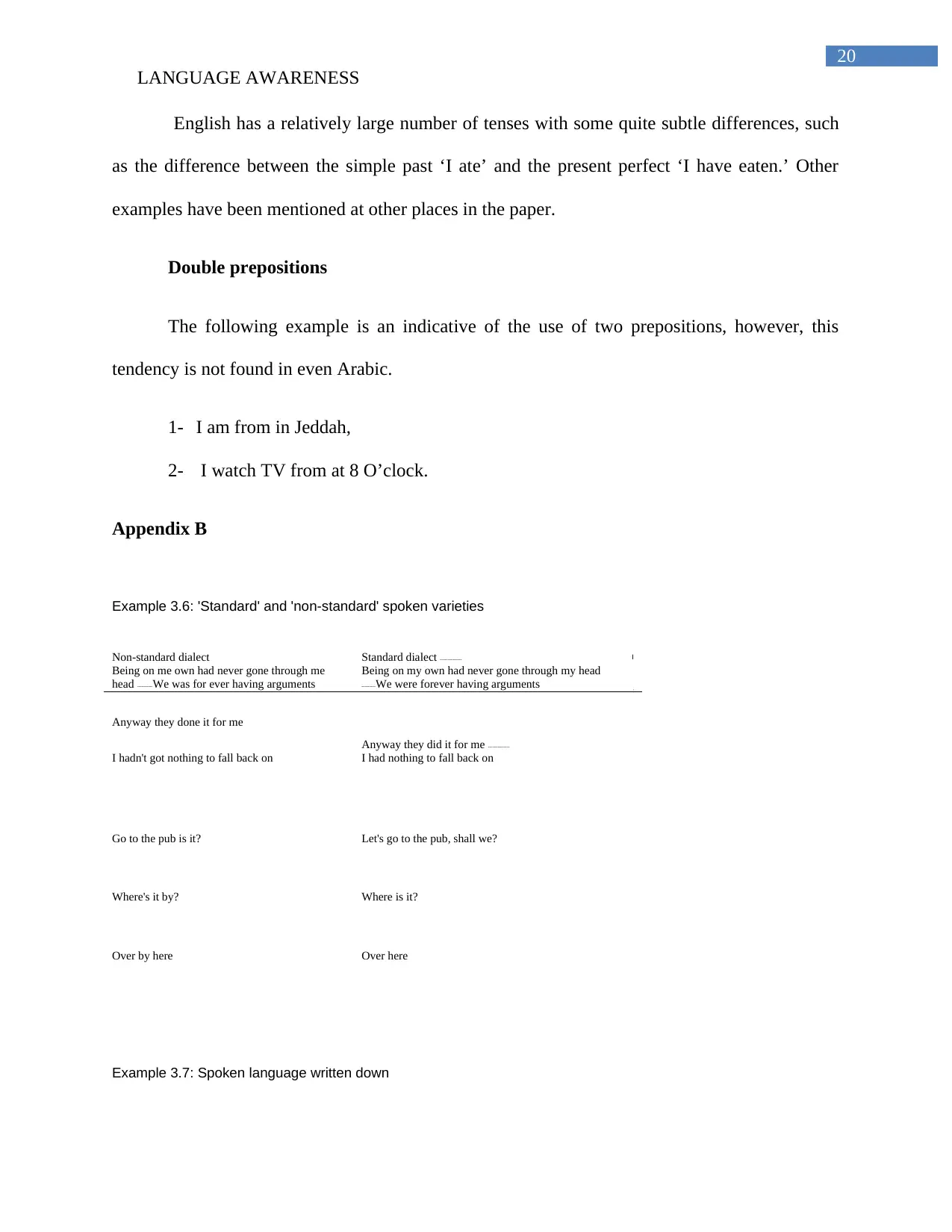
LANGUAGE AWARENESS
English has a relatively large number of tenses with some quite subtle differences, such
as the difference between the simple past ‘I ate’ and the present perfect ‘I have eaten.’ Other
examples have been mentioned at other places in the paper.
Double prepositions
The following example is an indicative of the use of two prepositions, however, this
tendency is not found in even Arabic.
1- I am from in Jeddah,
2- I watch TV from at 8 O’clock.
Appendix B
Example 3.6: 'Standard' and 'non-standard' spoken varieties
Non-standard dialect Standard dialect -------------- I
Being on me own had never gone through me
head ----------We was for ever having arguments
Being on my own had never gone through my head
---------We were forever having arguments •
Anyway they done it for me
Anyway they did it for me --------------
I hadn't got nothing to fall back on I had nothing to fall back on
Go to the pub is it? Let's go to the pub, shall we?
Where's it by? Where is it?
Over by here Over here
Example 3.7: Spoken language written down
⊘ This is a preview!⊘
Do you want full access?
Subscribe today to unlock all pages.

Trusted by 1+ million students worldwide

LANGUAGE AWARENESS
The speaker is telling a story in an unedited radio conversation programme. Just before the speaker tells the
story, the sub;ect of the conversation has been the invcnti/lg of stories and games by computer.
I've just started WORKing on one which is + urn + urn + + where the imajor objECTive of the gaa it's called
buREAUcracy the major objECTive of the game is actually + to get your BANK to acknowledge a change of
adDRESS card + urn + (laughter) i this will lead you from one + i one + HUGE EPic adventure to anOTHer though
in fa though the the the ONE thing that's imPELling you is just TRYing to get your bank to DO this + ithis
actually CAME from something that occurred to me when I when I MOVED to my current FLAT I got a
mortgage from the BANK + er + but nevertheless when I was sending OUT a change of address card I well I'd
better send them one ANYway they SHOULD know I'm here because they're PAYing for it + urn + + i urn + and
the next statement I got was + sent to myoid adDRESS so I sent them an i OTHer change of address card and the
next statement after THAT was sent to myoid adDRESS i so I WROTE them a letter saying look you i MUST
know I'm here because you're i INto this flat for x numbers of thousands of pounds +
+ urn + I've SENT you two changes of address cards + urn + i PLEASE will you sort of UPdate your records and
make sure you send stuff to my new adDRESS + i so they wrote me back a very + urn + a i POLoGETic letter saying
we DO realise this is VERy silly I'm sorry it won't happen again + + + .1 GUESS where they sent the LETter + +
Related Documents
Your All-in-One AI-Powered Toolkit for Academic Success.
+13062052269
info@desklib.com
Available 24*7 on WhatsApp / Email
![[object Object]](/_next/static/media/star-bottom.7253800d.svg)
© 2024 | Zucol Services PVT LTD | All rights reserved.





